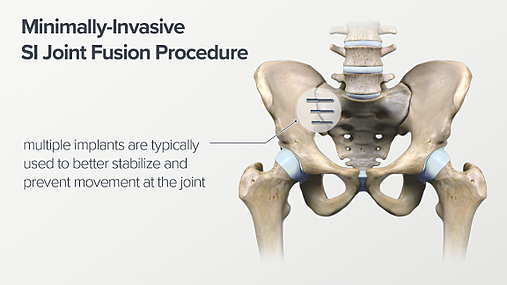
Up to 22% of all lower back pain occurs from pain generated from a problematic sacroiliac joint. With about 31 million Americans suffering from lower back pain, that means almost 7 million Americans are dealing with a sacroiliac joint that is not functioning properly.
Naturally, the medical community has been working on a solution to the problem for some time now. Sacroiliac joint surgery was actually first described all the way back in 1926.
Nowadays, the go-to surgery for patients that have immense lower back pain resulting from the sacroiliac joint is SI joint fusion. Most physicians believe that this type of surgery is the only way to relieve sacroiliac joint pain. The issue is that the surgery may not be all it is cracked up to be. Let’s dive into SI joint fusion surgery.
The SI Joint
The sacroiliac joint is one of the most important joints in the back. The joint absorbs all of the force from the upper body and transfers it down into the lower body. This makes the joint pivotal as a ton of force is constantly being transferred through the joint.
Damaging the joint can happen in anything from a car crash to a pregnancy. The joint is made up of several different pieces. The sacrum is part of the sacroiliac joint and it connects to the back disc right above the joint. Problems can arise in any part of the joint. Many healthcare professionals and patients turn to SI joint fusion surgery to solve the problem.
You can also read: CONTROLS THE CHRONIC PAIN AND IMPROVES YOUR LIFE WITH STEM CELLS.
What is the surgery?
The goal of SI joint fusion surgery is to stabilize the joint so it is unable to move. SI joint fusion surgery is supposed to be a minimally invasive surgery with low risks of complications and issues. When SI joint fusion surgery first came out there were many small studies that claimed there was almost no complications from the surgery.
A study that was released in 2016 actually found that the risk of complication was significantly higher than what was previously reported. Over 16% of patients had complications from the surgery after 6 months. Some of the previous studies claimed that the complication rate was as low as 3.5%.
Another potential issue is that a patient’s condition could be misidentified. An SI joint injury cannot be identified by an MRI or X-Ray, which makes detection and diagnosis extremely difficult. There are many other injuries that can mimic lower back pain, such as a hip problem. A healthcare professional may believe they are recommending the correct treatment path, but in reality they are making their patient go through unnecessary surgery.
Recovery Time
Generally, the recovery time of a patient who goes through the SI joint fusion procedure is about six months. For the first four to six weeks after surgery, you will likely be on crutches. The full recovery time is about six months. Six months is a long time for you to be out on the sidelines. The recovery time could just be another obstacle in a patient’s lower back pain journey. There are some complicated problems that could arise from SI joint fusion surgery as well.
Transfer of Pain
The degradation of the sacroiliac joint may be just a symptom of the overall problem. Fusing the joint together does not heal the ligaments and cartilage that have been worn down after a number of years. The ligaments will still have the same wear and tear after the surgery. This could lead to further back problems and additional surgeries for a patient who received the surgery.
So instead of the sacroiliac joint absorbing the pain, the force is transferred into other joints and parts of the body. The fused joint does not magically make everything better. Think of it like this; two broken rubber bands that are tied together do not solve the problem. It might be a short term fix for a long developing problem.
There is not enough long-term evidence to clearly showcase that SI joint fusion surgery does not cause adjacent segment disease. SI joint fusion surgery may not solve the root problem that a patient is experiencing. There has to be a better way.
You might be interested: CAN YOU TREAT A MENISCUS TEAR WITHOUT SURGERY?
Other methods
Most healthcare professionals will tell their patients that SI joint fusion surgery is the only option to cure their back pain. But, there are other methods that are potentially even more effective than surgery. Plus, patients will not have to deal with all of the headaches of normal surgery.
Stem cell therapy can fix the root cause of a patient’s back pain. The stem cells will completely rejuvenate the ligaments and cartilage that surround the SI joint. Stem cells encourage new growth in areas that have been dominant for years. The new cartilage and ligament cells will be able to handle all of the force that is put through the sacroiliac joint.
Not only will stem cells solve the root cause of your lower back pain, they are also less invasive than traditional SI joint fusion surgery. The cost is significantly less than traditional surgery.
The recovery time is also drastically less than surgery. A patient can feel the effects of stem cell therapy in just a few days, while surgery will take weeks. The benefits of stem cell therapy for sacroiliac joint pain is clear.
One of the reasons that healthcare professionals do not recommend stem cell or PRP therapy is the stigma around the treatments. Doctors do not want to recommend an ‘experimental’ procedure even though it could easily be a better solution than SI joint fusion.
Stem cell therapy should be your first option before even considering surgery. Talk to your healthcare professional about other options besides SI joint fusion. Your back will thank you later for not choosing surgery!



